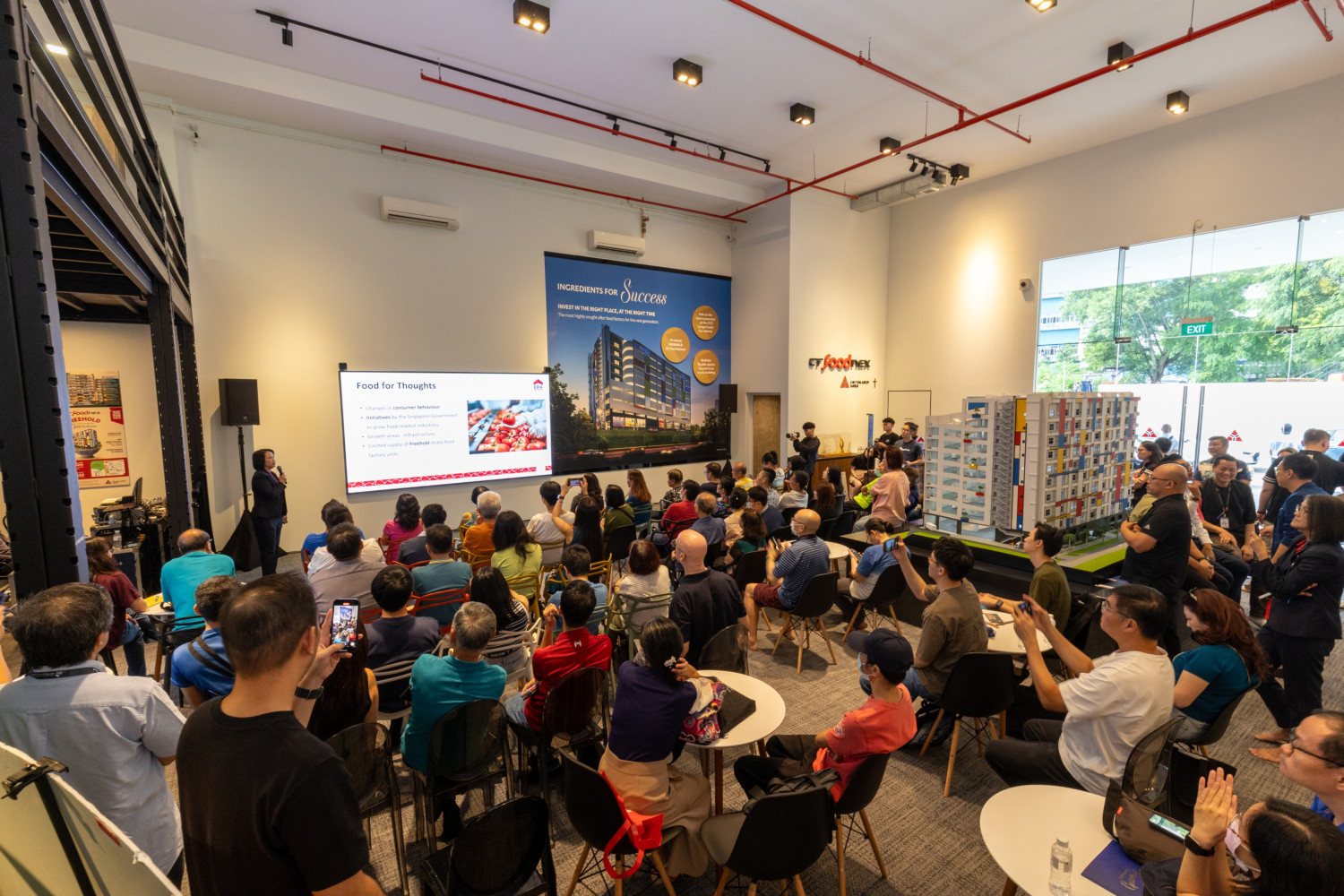Rising demand in food factories as an alternative investment: ERA
By Nur Hikmah Md Ali
/ EdgeProp Singapore |

Currently, the CT FoodHub factory has sold about 73% of their total units, says Daniel Phua, group division director at ERA Realty Network (Photo: Samuel Isaac Chua/EdgeProp Singapore)

The “Alternative Property Investment” seminar saw about 60 attendees at the CT FoodHub show flat on March 2 (Photo: Samuel Isaac Chua/EdgeProp Singapore)

About 2.4 million sq ft of multiple-user factory supply is likely to be completed by the end of the year (Photo: Samuel Isaac Chua/EdgeProp Singapore)

Freehold industrial lands are rare and majority of these sites are tightly held, says Pearl Lok, director of capital markets and investment sales at ERA Singapore (Photo: EdgeProp Singapore)

Currently, the CT FoodHub factory has sold about 73% of their total units, says Daniel Phua, group division director at ERA Realty Network (Photo: Samuel Isaac Chua/EdgeProp Singapore)

The “Alternative Property Investment” seminar saw about 60 attendees at the CT FoodHub show flat on March 2 (Photo: Samuel Isaac Chua/EdgeProp Singapore)

About 2.4 million sq ft of multiple-user factory supply is likely to be completed by the end of the year (Photo: Samuel Isaac Chua/EdgeProp Singapore)

Freehold industrial lands are rare and majority of these sites are tightly held, says Pearl Lok, director of capital markets and investment sales at ERA Singapore (Photo: EdgeProp Singapore)

Currently, the CT FoodHub factory has sold about 73% of their total units, says Daniel Phua, group division director at ERA Realty Network (Photo: Samuel Isaac Chua/EdgeProp Singapore)




SINGAPORE (EDGEPROP) - In the industrial space, multi-user factories registered the strongest rental growth of 10.7% y-o-y in 2023, propelled by newer, better-located stock, according to JTC’s 4Q2023 industrial report. Occupancy for multi-user factory developments stood at 92.2% at the end of last year.
According to Pearl Lok, ERA Singapore’s director of capital markets and investment sales, industrial prices will grow between 3% and 5% y-o-y in 2024, led by multi-user factories and warehouses, especially logistics spaces in prime locations. She expects rental growth to be in tandem with price growth — at 3% and 5% in 2024, led by multi-user factories and warehouses. The pace of rental growth is however, slower, compared to the 10.7% y-o-y increase in multi-user factory rents in 2023.
Lok was speaking at the “Alternative Property Investment: Exploring Industrial Property Trends and Food Factory Investment” seminar on March 2, organised by EdgeProp Singapore in partnership with Chiu Teng Group. The event was held at the CT Foodnex sales gallery at Mandai Estate, where over 60 people attended.
Advertisement
Advertisement
She attributes the slower pace of rental growth in the multi-user factory space this year to the 2.4 million sq ft of new supply entering the market. Some significant new developments expected to be completed in 2024 include JTC Bulim Square (1.69 million sq ft) and One KA@MacPherson (92,247 sq ft).
According to ERA, the total available industrial stock stood at 52.9 million sqm (569.1 million sq ft). New supply completed in 2023 made up 9.69 million sq ft in 2023. Lok says the bulk of future supply comprises single-user space, typically used by MNCs or companies for own operations and comes with short lease tenures of between 20 and 30 years. She adds that multiple-user factory spaces from IGLS range between 30 and 60 years.
“As such, freehold industrial spaces in Singapore are rare,” she notes. “The majority of freehold land is tightly held.”
One such freehold multiple-user industrial space that is available is CT FoodNex Hub. The 10-storey ramp-up food factory at Mandai Estate by developer Chiu Teng Group has 109 strata-titled industrial units and a canteen. Its B2 industrial units range between 1,700 and 2,928 sq ft, with prices starting from $2.5 million.
Since its launch in May 2023, about 73% of the industrial units at CT FoodNex have already been taken up, says Daniel Phua, group division director at ERA Realty Network, who was also a speaker at the event.
He expects the factory to remain attractive to investors due to its location. “The factory is located along the main road,” he points out. “It is also a 10-minute drive from the Johor customs, which will be convenient for workers coming in from Malaysia.”
Advertisement
Advertisement
Besides its freehold tenure, the building is designed with ramp-up access for 20-foot container trailers, he adds.
Phua sees demand for food factories continuing to increase, especially with the rise in the food delivery business, even after the pandemic. Hence, there is greater demand for food processing, cloud kitchens, food packaging and cold storage rooms.
Between 2012 and 2019, the number of non-retail food establishments grew at an average of 3.2% per annum, says ERA’s Lok. The pace of growth increased to 9.6% and 8.5% in 2021 and 2022, respectively. Lok attributes the growth to changing lifestyles, such as the prevalence of work-from-home arrangements and the increased need for convenience.
The government has also been pushing for more food facilities to be built to fulfil its “30 by 30” goal: to produce 30% of the nation’s nutritional needs by 2030 to achieve food security. It includes the development of the 500ha Sungei Kadut Eco-District manufacturing estate and the Northern Agri-Tech and Food Corridor to support agri-tech and environmental technology.
https://www.edgeprop.sg/property-news/demand-food-factories-exceed-supply-era


Follow Us
Follow our channels to receive property news updates 24/7 round the clock.
Subscribe to our newsletter
Related Articles
Advertisement
Advertisement
Advertisement
Top Articles
Search Articles
![[ERA IWD 2024] Brenda Zee: The realtor redefining client relationships across generations - EDGEPROP SINGAPORE](https://img.tepcdn.com/img-v2/a/m-h_628,w_1200,g_cm/5396316/84158092/4d6092a3-0745-4d6c-8f2c-a20a322a90b2.jpg)
![[ERA IWD 2024] Joelle Chew: An empowering leader who changes lives, one property at a time - EDGEPROP SINGAPORE](https://img.tepcdn.com/img-v2/a/m-h_628,w_1200,g_cm/5396324/84158475/b114a18b-c1d1-44b8-9d76-6f7ebc4b3bae.jpg)
![[ERA IWD 2024] Tracy Teo: Embracing the role of mentoring a new generation of agents, empowering them along their journey - EDGEPROP SINGAPORE](https://img.tepcdn.com/img-v2/a/m-h_628,w_1200,g_cm/5396373/84158630/94940fdb-4f60-43d5-8196-b1e6c8878fb2.jpg)